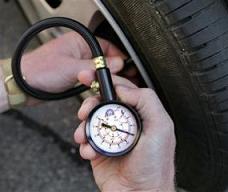This post originally ran on the Wonk Room.
 For most of this year rising gas prices have been on everyone’s mind. Believe me, the auto industry understands very well just how much of an impact $4/gallon gas has had on American consumers. As you may have seen, it’s having an impact on us, as well.
For most of this year rising gas prices have been on everyone’s mind. Believe me, the auto industry understands very well just how much of an impact $4/gallon gas has had on American consumers. As you may have seen, it’s having an impact on us, as well.
Last week, the Auto Alliance and the National Auto Dealers Association sponsored tire pressure checks for members of Congress and their staff who park in the Rayburn Office Building. Surprisingly, we found that most drivers had tires between 5 and 7 pounds under inflated — some had tires under-inflated by as much as 20 pounds. This significantly reduced their vehicle’s fuel economy.
We all share a goal of increasing fuel economy, as well as enhancing energy security and reducing greenhouse gas emissions, and the fuel economy increases passed last year by Congress (and supported by the Auto Alliance) will help. But consumers want ways to fight back against high gas prices right now. By properly inflating tires, we can have an immediate impact on the more than 245 million vehicles currently on our nation’s roads and highways.
Earlier this year, we cosponsored the Alliance to Save Energy’s Drive Smarter Challenge. As part of this campaign we advocated maintaining proper tire pressure as one simple step consumers could take to increase fuel economy and reduce carbon dioxide emissions. It’s more important than you may think. For instance, did you know…
• The Department of Energy estimates that 1.2 billion gallons of fuel were wasted in 2005 as a result of driving on under-inflated tires.
• Fuel efficiency is reduced by 1% for every 3 PSI that tires are under-inflated.
• Proper tire inflation can save the equivalent of about 1 tank of gas per year.
• Proper tire inflation also reduces CO2 emissions.
• Experts estimate that 25% of automobiles are running on tires with lower than recommended pressure, because people don’t know how to check their tires or don’t realize that tires naturally lose air over time.
Maintaining proper tire pressure may not solve our dependence on foreign oil, but it will help. Consumers can get a few more miles to gallon, and when combined other driving and maintenance tips, those small steps can help to make a serious improvement in vehicle fuel economy.


